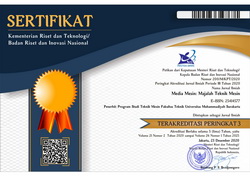ANALISIS KARAKTERISTIK BRIKET ARANG DENGAN VARIASI TEKANAN KEMPA PEMBRIKETAN
Rany Puspita Dewi(1*), Trisma Jaya Saputra(2), Sigit Joko Purnomo(3)(1) Jurusan Teknik Mesin, Universitas Tidar
(2) Jurusan Teknik Mesin, Universitas Tidar
(3) Jurusan Teknik Mesin, Universitas Tidar
(*) Corresponding Author
Abstract
Keywords
Full Text:
PDF (Bahasa Indonesia)References
A. Dewi Agustin, M. Riniarti, and . D., “Pemanfaatan Limbah Serbuk Gergaji Dan Arang Sekam Padi Sebagai Media Sapih Untuk Cempaka Kuning (Michelia Champaca),” J. Sylva Lestari, vol. 2, no. 3, pp. 50–58, 2014.
A. Yulia, F. P. Sari, and M. Arisandi, “Analisis Kelayakan Pendirian Usaha Pengolahan Tempurung Kelapa di Kecamatan Pengabuan, Kabupaten Tanjung Jabung Barat, Provinsi Jambi,” Ind. J. Teknol. Dan Manaj. Agroindustri, vol. 8, no. 2, pp. 145–153, 2019.
R. Setiowati and M. Tirono, “Pengaruh Variasi Tekanan Pengepresan dan Komposisi Bahan Terhadap Sifat Fisis Briket Arang,” J. NEUTRINO, vol. 7, no. 1, pp. 23–31, 2014.
D. Purwanto, “Pengaruh Ukuran Partikel Tempurung Sawit Dan Tekanan Kempa Terhadap Kualitas Biobriket,” J. Penelit. Has. Hutan, vol. 33, no. 4, pp. 303–313, 2015.
F. K. Pambudi and W. Nuriana, “Pengaruh Tekanan Terhadap Kerapatan, Kadar Air, dan Laju Pembakaran Pada Biobriket Limbah Kayu Sengon,” Semin. Nas. Sains Dan Teknol. Terap. VI 2018, pp. 547–554, 2018.
S. Huda, G. Rubiono, and I. Qiram, “Pengaruh Variasi Tekanan Dan Komposisi Bahan Terhadap Pembakaran Briket Kulit Kopi (Coffea Canephora) Banyuwangi,” J. V-Mac, vol. 3, no. 2, pp. 28–31, 2018.
D. Purwanto, “Pengaruh Tekanan Kempa dan Konsentrasi Perekat Terhadap Sifat Biobriket Dari Limbah Tempurung Sawit,” J. Ris. Ind. Has. Hutan, vol. 7, no. 2, pp. 1–8, 2014.
A. Nugraha, A. Widodo, and S. Wahyudi, “Pengaruh Tekanan Pembriketan dan Persentase Briket Campuran Gambut dan Arang Pelepah Daun Kelapa Sawit terhadap Karakteristik Pembakaran Briket,” J. Rekayasa Mesin, vol. 8, no. 1, pp. 29–36, 2017.
L. Lestari and E. S. Hasan, “Pengaruh Tekanan Dan Ukuran Partikel Terhadap Kualitas Briket Arang Cangkang Coklat,” J. Apl. Fis., vol. 13, no. 2, pp. 1–8, 2017.
Article Metrics
Abstract view(s): 1368 time(s)PDF (Bahasa Indonesia): 2484 time(s)
Refbacks
- There are currently no refbacks.








